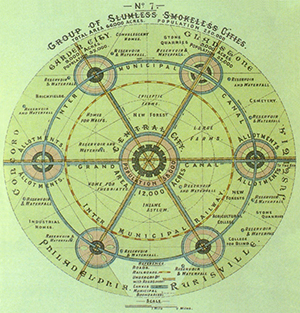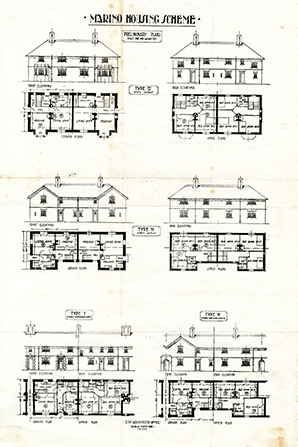Building Ireland: Marino garden suburb
Published in Issue 6 (November/December 2020), Reviews, Volume 28RTÉ1
10 September 2020
Esras Films
By Donal Fallon

Above: The original ‘Garden City’ concept by Ebenezer Howard, 1902, on which Marino was based. Howard advocated a model that combined the best of urban and rural features, placing strong emphasis on shared communal green spaces and a movement away from the slum-ridden and congested city core.
RTÉ’s Building Ireland is not, on the face of it, a historical series, yet the past is a thread that runs throughout as it explores Ireland’s built heritage. Geographer Susan Hegarty, a contributor, has noted that it seeks to ‘bring viewers on a journey around Ireland and explain aspects of built heritage and local landscapes which many people may see on a daily basis but which they rarely question’.
To date, the popular series has included Dublin Airport’s impressive old terminal building and the remarkable story of the Ardnacrusha power station. These are subjects that would undoubtedly interest many readers of History Ireland from a historical perspective—to understand why they were constructed—but Building Ireland is as much about how they were constructed.
The return of the show for a stand-alone episode on Marino was a welcome addition to autumn programming. The national broadcaster has, like all broadcasters, been compelled to fall back on repeat programming and classics from the archival vaults, but there is only so much Italia ’90 a nation can relive.
The story of Marino—the first major suburban development of the Irish Free State—lends itself brilliantly to the format of Building Ireland and to collaboration between geographers, engineers and architectural historians. Pre-dating the career of housing architect Herbert Simms, in office from 1932 until 1948 and associated with beautiful Art Deco housing schemes in the city and large-scale suburban developments like Crumlin and Cabra, Marino was a suburb unlike any other that would be constructed in the capital. Here the ‘Garden City’ ideas of the urban planner Ebenezer Howard were brought to life. Howard advocated a model that combined the best of urban and rural features, placing strong emphasis on shared communal green spaces and a movement away from the slum-ridden and congested city core.

Above: Marino house plans.
Those who live in Marino often joke about its maze-like feel on moving to the area, a seemingly endless series of green spaces making orientation difficult; as Building Ireland reveals, however, its open-plan nature was not an accident but a conscious design. Architect Orla Murphy, geographer Susan Hegarty and architectural historian Ellen Rowley all explore different aspects of the Marino story.
At the outset, the programme provides a potted history of the housing crisis in Dublin and the factors that motivated the construction of Marino in the first place. The 1914 Housing Inquiry, published in the aftermath of tragedy on Dublin’s Church Street when two tenement houses collapsed with the loss of seven lives, is explored. It not only revealed the staggering scale of Dublin’s slumdom—a product of the absence of industry in the city—but also demonstrated the extent to which municipal politicians directly benefited from the crisis as tenement landlords and investors. In these early moments of historical contextualisation, Murphy speaks from 14 Henrietta Street, a museum that explores the story of a Dublin house from Georgian splendour to post-independence tenement. (It has become something of a television star itself in recent times, featuring in a wide variety of historical and social documentaries.)
It is in Marino itself that the programme becomes much more visually interesting. My first introduction to the work of Ellen Rowley, eight years ago, was a video produced by documentary director Paddy Cahill, who recorded Rowley cycling through the city streets and discussing the work of Herbert Simms. Here again Rowley is on a bicycle, an innovative way of exploring the district beyond the simple walking narrator shots. Given that the vision of Marino revolved around green space, the programme also lavishly avails of drone shots. The over-dependence on drone shots in contemporary documentary is something discussed in the last issue, examining Michael Portillo’s documentary on the War of Independence in which such shots were used excessively, but they give essential material to Building Ireland in clearly exhibiting the Marino landscape as envisioned in the 1920s and as still largely present today. As urban geographer Joe Brady, a Marino native, is interviewed on the garden suburb idea, we see it before our eyes in the aerial shots.
A feature of Esras Films’ work is the innovative use of animation, best utilised here with Dublin Corporation archival materials. The plans for Marino homes are no longer merely pieces of paper but moving sketches before us, explained in real time.
There was, perhaps, too little emphasis on the negative dimension of the story—the fact that Marino was above and beyond the means of those who most needed housing in the capital. The story of Marino tells us much about the approach of the new state to housing and, indeed, to class relations. The houses were provided on a tenant purchase model, essentially to create property-owning citizens, while payments were high enough that a problem was revealed almost immediately: general labourers could only dream of living there. In the words of the Irish Times, Marino was providing homes for what it termed the ‘aristocracy of labour’, the skilled working classes. Cabra, Crumlin and Kimmage may have lacked the flair of Marino a decade later but they provided homes for those who needed them most.
An added bonus were the recollections of the Tuesday Club, a group of local senior citizens whose collective memory stretches back to the Marino of the 1930s. While the primary selling point of Building Ireland was the presentation by experts in their diverse fields—who better to explain geography than a geographer, or engineering than an engineer?—the oral history dimension was a brilliant unexpected addition. An oral history of suburbia surely awaits whichever production company moves first.
The ability of Building Ireland to explain complex things in an informative and entertaining manner makes it one of the most outstanding productions of home-grown television in recent years. It demonstrates the benefits of an interdisciplinary approach to any subject.
Donal Fallon is presenter of the Dublin social history podcast Three Castles Burning and lectures in the Lifelong Learning Department of UCD.
















